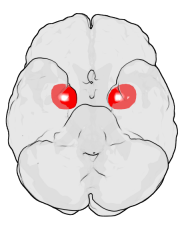
Photo from wikipedia
information. Translational research in both rodents and humans has honed in contextual processing from a psychological perspective to its core brain circuitry—the amygdala–hippocampal circuit, which appears to be conserved across… Click to show full abstract
information. Translational research in both rodents and humans has honed in contextual processing from a psychological perspective to its core brain circuitry—the amygdala–hippocampal circuit, which appears to be conserved across species (Milad and Quirk, 2012). Structural and functional alterations of this circuit have been observed in patients with neuropsychiatric disease, and are associated with a negative emotional memory bias and a broader fear generalization gradient (Gerritsen et al, 2012). Translating from ‘circuit neuroscience’ to ‘circuit neurotherapy’ requires understanding of the oscillatory mechanisms controlling amygdala–hippocampal interactions during the processing of salient information. In our recent study (Zheng et al, 2017) using direct human intracranial recordings, we demonstrated unidirectional influence from the amygdala to the hippocampus during contextual fear processing. In addition, we showed that such modulation is mediated through coherent theta and alpha frequency oscillations between these two core brain structures. Neuropsychiatric disorders are primarily treated with pharmacological means, targeting large swaths of brain tissue. To capture the underlying mechanistic process, a circuit-level perspective might provide a deeper understanding of neuropsychiatric disorders and improved interventions with greater efficacy and fewer side effects. A potential clinical application of our study is the modulation of oscillatory phase couplings between the amygdala and the hippocampus. Phase alignment or coupling between brain regions provides a temporal window for coordinated interregional information transfer and communication. Information transfer errors may occur due to over-coupling or under-coupling between brain structures, including failures in terminating irrelevant communication or extracting meaningful signals. These alterations in communication dynamics have been proposed to underlie neuropsychiatric disorders (Voytek and Knight, 2015). To ‘break’ such pathological couplings, amygdala–hippocampal network interactions could be altered with stimulation-based therapy to induce temporal phase synchronization (eg, enhanced phase alignment with phase resetting) or desynchronization (eg, reduced phase alignment with neural noises) between the two brain structures. This provides a theoretical framework for circuit-specific and stimulation-based intervention approaches, such as deep brain stimulation, transcranial alternating current stimulation (tACS), and transcranial magnetic stimulation. Furthermore, greater specificity can also be achieved by taking individual oscillatory variation into account. For example, using tACS parameters specific to individuals’ dominant theta frequency improves short-term memory capacity (Vosskuhl et al, 2015). Our study also showed that instead of conforming to the conventional definition of theta (4–7Hz)/alpha (8–12Hz) frequency rhythms, amygdala–hippocampal dynamics are contingent upon subject-specific low frequency oscillations (Zheng et al, 2017). Identifying such individualized electrophysiological features in patients with psychiatric disorders could enable stimulation parameters to be tailored for subjectpreferred neuronal firing frequencies, leading to personalized therapeutic interventions.
Journal Title: Neuropsychopharmacology
Year Published: 2018
Link to full text (if available)
Share on Social Media: Sign Up to like & get
recommendations!